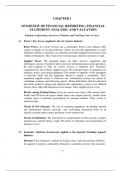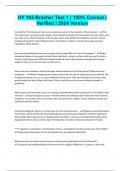CHAPTER 1
OVERVIEW OF FINANCIAL REPORTING, FINANCIAL
STATEMENT ANALYSIS, AND VALUATION
Solutions to Questions, Exercises, Problems, and Teaching Notes to Cases
1.1 Porter’s Five Forces Applied to the Air Courier Industry.
Buyer Power. Air courier services are a commodity. Firms in the industry offer
similar overnight or two-day deliveries. Firms also provide opportunities to track
shipments. Business customers can negotiate favorable shipping terms based on the
volume of shipments. Thus, buyer power among large corporate customers is high.
Supplier Power. The principal inputs are labor services, equipment, and
information systems. Except for pilots and some information-processing specialists,
the skill required to offer air courier services is relatively low. Therefore,
competition for jobs reduces supplier power. The principal items of equipment are
airplanes, trucks, and sorting equipment. The number of suppliers of this equipment
is relatively small, but the equipment offered is largely a commodity. Thus,
equipment supplier power is relatively low. Information systems are critical to
scheduling, tracking, and delivering parcels. Hiring individuals with the education
and skills needed to design and maintain this information system is not difficult
because these skills and education are not unique. Thus, supplier power is low.
Rivalry among Existing Firms. Seven air couriers now carry a 90% market share.
FedEx and UPS have the largest market shares and compete heavily. Smaller firms
compete more in particular geographical or customer markets. Thus, rivalry is
relatively high.
Threat of New Entrants. The cost of acquiring equipment, developing national
and international delivery networks, and overcoming entrenched firms in an
already-crowded market makes the threat of new entrants low.
Threat of Substitutes. The main threat to transportation of letter parcels is digital
transmission, and that threat is high. The threat of substitutes for transportation of
packages is low.
1.2 Economic Attributes Framework Applied to the Specialty Retailing Apparel
Industry.
Demand. Firms attempt to compete on design, colors, and other product attributes,
but apparel is largely a commodity. Demand is somewhat cyclical with economic
1-1
,Chapter 1
Overview of Financial Reporting, Financial
Statement Analysis, and Valuation
conditions; customers tend to delay purchases or trade down during economic
downturns. Demand is seasonal within the year. Demand grows at the growth rate
in population, which suggests that apparel retailing is a relatively mature market. To
the extent that retailers can generate customer loyalty, demand is not highly price-
sensitive. However, given the similarity of product offerings across firms, firms
cannot price their goods too much out of line with those of their competitors.
Supply. In most markets, there are many firms selling similar apparel. The barriers
to entry are not particularly high because an apparel line and retail space are the
most important ingredients.
Manufacturing. The manufacturing process is labor-intensive. The manufacturing
process is relatively simple, and firms source their apparel from Asia, which has
low wages.
Marketing. Because of the large number of suppliers selling similar products,
apparel-retail firms must stimulate demand with attractive store layouts, colorful
product offerings, and various sales promotions.
Investing and Financing. Firms must finance inventory, usually with a
combination of supplier and bank financing. The risk of inventory obsolescence is
somewhat high if the product offerings in a particular season do not sell. Firms tend
to rent retail space in shopping malls, so they need to engage in extensive long-term
borrowing.
1.3 Identification of Commodity Businesses.
Dell. Dell’s products—computers, servers, and printers—are commodities. Dell
tends not to develop the technologies underlying these products. Instead, it
purchases the components from firms that develop the technologies
(semiconductors and computer software). Dell’s direct-to-customer marketing
strategy is not unique, but the extent to which Dell performs this strategy better than
anyone else in the industry gives it a competitive advantage. Its size, purchasing
power, quality control, and efficiency permit it to operate as a low-cost provider.
Southwest Airlines. Airline transportation is a commodity service in the sense that
seats on one airline cannot be differentiated from seats on another airline.
Southwest Airlines’ strategy is to be the lowest-cost provider of such services,
thereby differentiating itself on low prices.
Microsoft. The basic idea of a commodity product is that the product offerings of
one firm are so similar to those of other firms that customers can easily switch to
competitors’ products if price becomes an issue. The technological attributes of
1-2
, Chapter 1
Overview of Financial Reporting, Financial
Statement Analysis, and Valuation
computer software are duplicated relatively easily, a commodity attribute. However,
Microsoft’s size permits it to invest in new technology development and keep it on
the leading edge of new technologies. Microsoft also has a huge advantage in terms
of installed base, meaning that most customers almost have to purchase its software
to be able to use application programs and to communicate with other computer
users. Thus, its products are inherently commodities, but Microsoft is able to
overcome some of the disadvantages of commodity status.
Johnson & Johnson. Johnson & Johnson operates in three business segments:
consumer health care, pharmaceuticals, and medical equipment. It derives the
majority of its revenue and profits from the latter two industries. Patents protect the
products of these two industries, which give the firm a degree of market power.
Until another firm creates a new product that dominates the patented product of
Johnson & Johnson, its product is not a commodity. However, rapid technological
change makes most products obsolete before the end of the patent’s life. Johnson &
Johnson’s products probably have fewer commodity attributes than the other three
firms in this exercise.
One of the purposes of this exercise is to illustrate that firms can pursue product
differentiation strategies and low-cost leadership strategies and, if performed well,
can gain “most admired status.”
1.4 Identification of Company Strategies. The strategies of Home Depot and Lowe’s
are marked more by their similarities than by their differences. Both firms sell to the
do-it-yourself homeowner and the professional builder, plumber, or electrician at
competitively low prices. Their in-store product offerings are similar, roughly
evenly split between building materials, electrical and plumbing supplies, hardware,
paint, and floor coverings. Their store sizes are approximately the same. Both use
sales personnel with expertise in a particular home improvement area to offer
advice to customers. Both rely on third-party credit cards for a large portion of their
sales to customers. They are similar in size in terms of number of stores, which are
located primarily throughout North America.
1.5 Researching the FASB Website. The answer will change over time as the FASB
updates its activities. The purpose of the exercise is to familiarize students with the
FASB website and the kinds of information they can find there.
1.6 Researching the IASB Website. The answer will change over time as the IASB
updates its activities. The purpose of the exercise is to familiarize students with the
IASB website and the kinds of information they can find there.
1-3
, Chapter 1
Overview of Financial Reporting, Financial
Statement Analysis, and Valuation
1.7 Effect of Industry Economics on Balance Sheets. Among the three firms, Intel
faces the greatest risk of technological change for its products. Although the
manufacture of semiconductors is capital-intensive, Intel does not add financial risk
to its already high business risk. Thus, Firm B is Intel. The revenues of American
Airlines and Walt Disney change with changes in economic conditions, subjecting
them to cyclical risk and, thereby, reducing their use of long-term debt. Besides
producing movies and family entertainment, Disney operates theme parks, which
the firm does not include in property, plant, and equipment. This will reduce its
property, plant, and equipment to total assets percentage. American Airlines has
few assets other than its flight and ground support equipment. Thus, Firm A is
Disney and Firm C is American Airlines. It may seem strange that Disney has
smaller proportions of long-term debt in its capital structure compared to American
Airlines. One possible explanation is that the assets of American Airlines have a
ready market in case a lender repossesses and sells them than do the more unique
assets of Disney. This reduces the borrowing cost. In this case, however, the
explanation lies in the fact that American Airlines has operated at a net loss for
several years and has negative shareholders’ equity. The result is a higher ratio of
long-term debt to assets for American Airlines than for Disney.
1.8 Effect of Business Strategy on Common-Size Income Statements. Firm A is Dell
and Firm B is Apple Computer. The clues appear next.
Cost of Goods Sold to Sales Percentages. One would expect Dell to have a higher
cost of goods sold to sales percentage because it adds less value, essentially
following an assembly strategy, and competes based on low prices. Apple
Computer can obtain a higher markup on its manufacturing costs because it creates
more unique products with a somewhat unique consumer following.
Selling and Administrative Expense to Sales Percentages. Both Dell and Apple
Computer engage in extensive promotion to market their products to consumers,
thereby increasing their selling expenses. One might expect Apple Computer to
spend more on marketing and advertising than Dell would spend. One also might
expect Dell, as a producer of commodities, to be more focused on controlling costs
such as administrative expenses. So it is interesting that Apple’s selling and
administrative expenses are considerably smaller than Dell’s.
Research and Development Expense to Sales Percentages. Apple Computer is
more of a technology innovator than Dell, thereby giving Apple Computer a higher
R&D (research and development) expense to sales percentage.
Net Income to Sales Percentages. These percentages are consistent with the
strategies of these firms. Compared to Dell, Apple Computer has a much higher
profit margin.
1-4





